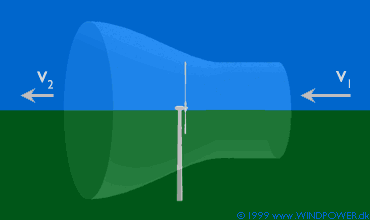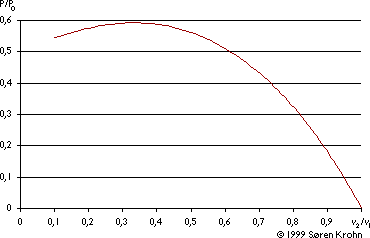

Proof
of Betz' Law
This page gives a proof of Betz' law. Before reading this page you should have read the pages in the Guided Tour on how the wind turbine deflects the wind and Betz' Law. If you do not follow the argument in detail, just glance through the rest of this page, which uses Betz' own reasoning from his book Wind-Energie from 1926 to explain the law.
Proof
of Betz' Theorem

![]() Let
us make the reasonable assumption that the average wind speed
through the rotor area is the average of the undisturbed wind
speed before the wind turbine, v1, and the wind speed
after the passage through the rotor plane, v2, i.e.
(v1+v2)/2. (Betz offers a proof of this).
Let
us make the reasonable assumption that the average wind speed
through the rotor area is the average of the undisturbed wind
speed before the wind turbine, v1, and the wind speed
after the passage through the rotor plane, v2, i.e.
(v1+v2)/2. (Betz offers a proof of this).
![]() The
mass of the air streaming through the rotor during one second
is
The
mass of the air streaming through the rotor during one second
is
where m is the mass per second, ![]() is the density of air, F is the swept rotor area and [(v1+v2)/2]
is the average wind speed through the rotor area. The power
extracted from the wind by the rotor is equal to the mass times
the drop in the wind speed squared (according to Newton's second
law):
is the density of air, F is the swept rotor area and [(v1+v2)/2]
is the average wind speed through the rotor area. The power
extracted from the wind by the rotor is equal to the mass times
the drop in the wind speed squared (according to Newton's second
law):
Substituting m into this expression from the first equation we get the following expression for the power extracted from the wind:
Now, let us compare our result with the total power in the undisturbed wind streaming through exactly the same area F, with no rotor blocking the wind. We call this power P0:
The ratio between the power we extract from the wind and the power in the undisturbed wind is then:
We may plot P/P0 as a function of v2/v1:

We can see that the function reaches its maximum for v2/v1 = 1/3, and that the maximum value for the power extracted from the wind is 0,59 or 16/27 of the total power in the wind.
Click here to go back the Guided Tour page on Betz' Law.
© Copyright 1999 Soren Krohn
Updated 6 August 2000
http://www.windpower.org/stat/betzpro.htm